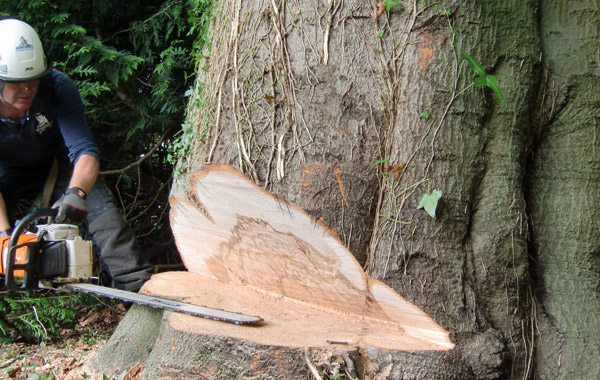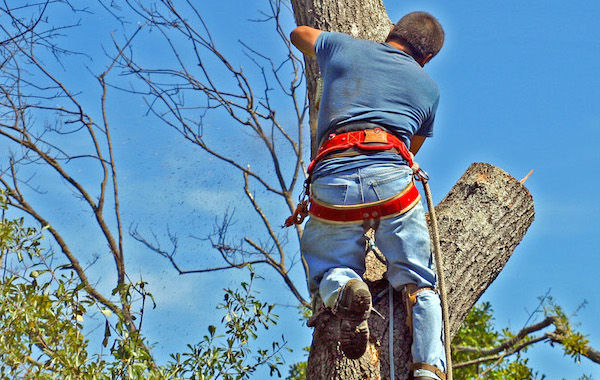Tree Lopping & Tree Felling
Despite your best intentions, it is not always possible to avoid removing a tree from your property. Trees of all sizes may be subjected to rot, pests or disease that may structurally compromise the tree and create a potential danger to houses, animals and people. Arborists are specialists in the care and management of trees. Arborist can assist individual homeowners, farmers, local authorities and businesses in managing their property maintenance and tree lopping and service needs. Well-maintained trees provide welcome shade and are visually appealing whether they are located on a standard suburban block or in the middle of a farming paddock.
Professional Tree Services | Tree Lopping Solutions
Damage, disease or safety concerns can turn some trees from an asset into a liability. When this occurs, Tree Lopping Solutions certified arborists can be trusted for safe and efficient tree removal service. Our certified arborists are committed to you and the health and safety of your trees.
Contact Us
Professional Tree Lopping Services
Tree felling or tree lopping is the process of downing individual trees from ground level. In open areas such as parks acreage or large estates where there is adequate room this may be an option.Tree Lopping Arborsts Professionals
Good tree lopping skills means that the tree is felled precisely where it is required to fall and nowhere else avoiding unnecessary damage to other plants, trees or structures. In urban situations tree felling is often not the safest option or possible and sectional dismantling of tree using ropes and lowering devices is adopted.
Tree Maintenance & Tree Lopping
Tree Lopping is a very controlled way of dismantling any size tree irrespective of location and allows us to direct and lower sections of trees exactly where we want them to go. This allows a skilled and experienced arborist or team to remove trees without impacting the surrounding areas.Utilising Professional Tree Felling Professionals
Gardens take time to establish and are not something that can be replaced over night. So when the time comes where a tree needs to removed or felled you want to ensure that your gardens and property are protected.
Comprehensive Tree Felling
Employing a professional tree service company with a proven track record will improve your chances of a successful and prompt tree lopping service. It may be tempting to go for the cheapest quote but you want to be sure that the necessary care be taken.Tree Felling and Tree Lopping is a Job for Professionals
Cutting a tree from ground level or felling it in a few large pieces takes a lot less time than carefully dismantling the tree using ropes and pulleys to protect your garden and property. You want to be sure that you don’t spend excessive time or money repairing damaged gardens or property.
Storm & Emergency Response
Equipped to assist any emergency that involves a tree removal or tree damage, arborists have the skills and knowledge to best assist homeowners, business owners, councils and insurance assessors when damage to property is caused by fallen trees. Tree Lopping Solutions we understand the unpredictable role the weather and storms can cause to Australian residents. Arborists are prepared with all of the equipment necessary to undertake storm and emergency clean-up services on behalf of our residential and commercial clients. Among our storm damage tree services and emergency tree work and clean up, we can assist with the removal of debris and damaged branches caused by high winds, storms or natural disasters.
Having a tree falling over, splitting or dropping a large branch onto your home or property can be a shocking and traumatic experience. With unpredictable weather and wild winds, emergency tree removal is a common need for many Australian home owners and insurance companies. Tree Lopping Solutions responds promptly to emergency tree removal requests in order to make the area safe, minimise further damage to your property, and restore your sense of safety and security.
Getting expert advice from a qualified arborist is crucial in order to get the best outcome in an emergency tree removal situation. An arborist will be able to skilfully and efficiently assess how a tree will react to certain conditions. What type of tree is it? Is it stable? Will it split further? How will the tree likely react to continuing harsh weather? Only an arborist can provide an expert assessment on the best course of action.
When storm damage occurs qualified and experienced arborist team are available to help with the clean up. With good pruning techniques and proper tree management, your trees can stand up well when strong winds come through. If however, you require some urgent work after a storm that has resulted in fallen trees and hanging branches arborists provide a 24hr hour emergency call out service. If you are worried about the structure and stability of your tree after a big blow or require general debris removal and yard tidy up, experienced arborists are on stand by to assist promptly and efficiently.
Crown Reduction
Tress and shrubs are a great addition to any yard, adding curb appeal and protection against the weather. Unfortunately, many homeowners only take into account a tree’s ability to provide shade and coolness during the hot summer months. Choosing the incorrect tree that can grow sky-high and pose a serious risk at a certain point in the future. Crown reduction and pruning greatly affects the growth form, vigour and stability of your tree if pruned incorrectly. When dealing with tree pruning and crown reduction, it is a job best left to a professional arborist to ensure your yard is not left a disaster zone, and your tree remains happy and healthy.
Crown reduction is generally reducing the size of the tree canopy in spread or height by selectively pruning certain limbs back to lateral branches capable of sustaining the remaining limb. In simple terms this means the overall structure of the tree and future growth is still stable and in balance. In some cases the selective pruning of certain limbs may be done to allow a specific view, known as vista pruning, but this must not disrupt the overall balance of the tree and it may require shaping to ensure this. The choice of pruning is also often determined by the species of tree since for example eucalyptus trees should never really be crown reduced vertically whereas deciduous trees such as liquid ambers are more tolerant.
Crown reduction pruning, is most often used when a tree has grown too large for its permitted space. This method is preferred to topping because it results in a more natural appearance, increases the time before pruning is needed again, and minimises stress on the tree. This procedure removes the end of a branch by cutting back to a “crotch” created by a lateral branch. Employing this method insures the tree will produce fewer sprouts at the point of the cut and the natural growth of the tree will be preserved.
The main purpose of the crown reduction technique is to ensure the process of cutting branches back to a suitable growth point is utilised to maintain the tree’s natural shape and appearance. This allows the whole tree and crown size to be reduced while still maintaining the shape of the tree. It allows more space and light in your garden as well as controlling the tree’s size. Crown reduction is sometimes considered when the root systems of a tree has substantially decayed making it potentially hazardous. It should not be considered as a preventative measure for storm or high wind weather as crown thinning is recommended for this.
Tree Surgery & Maintenance
When tree surgery work is required, it is critical that the correct maintenance plan be applied to ensure that the desired outcome is met without going to far and stressing the tree causing lots of regrowth that becomes a maintenance nightmare in the future. Trees in your home will always need some attention at some point and we do recommend pruning and trimming your trees but if correct methods are used then it should be some time before you need to call an arborist back.
Qualified arborists learned in arboriculture practices can recommend the best course of action to provide maximum long term aesthetics and good structural form to your trees. An experienced tree surgery professional is also able to provide you with advice on implementing preventative measures such as, potential storm damage and solutions, root management and the impact of trees and infrastructure. Skilled arborists are knowledgeable in the best practice to prune, maintain and care for your trees to assess what needs to be done to keep them in the best shape they can be for as long as possible.
A healthy tree is a happy tree. Maintaining the health and integrity of your trees helps to provide an aesthetically pleasing yard and outlook. Tree surgery and tree maintenance performed by qualified arborists helps to support them in sustaining a long and healthy life.
The advantages of qualified arborists maintaining your trees include:
- Pruning allows more light in and can open up a view
- Minimises overhanging branches from touching power lines
- Helps to prepare for storm season by removing deadwood and weak unions
- Reduce dead leaves and branches falling into gutters
- Allow more light onto solar panels
Tree surgery is part of the arboriculture process performed by a qualified and experienced arborist. It involves the physical maintenance and manipulation of trees at risk of collapse or death. Tree surgery is performed by a qualified tree surgeon. A tree surgeon is an arborist that specialises in tree health and safety practices. Tree surgery helps trees heal from pest infestations, disease, rot and fungal attacks, and recover from past damage and mistreatment. Tree surgeons help preserve trees by keeping them healthy and safe.
Wood Chipping, Garden Mulch & Firewood
Once an arboist has finished pruning, lopping or felling you trees, you’ll be left with tree branches, limbs, trucks and a general mess. Professional arborists have the tools and skills to assist in the removal and clean up of your garden waste. Utilising wood chippers, chainsaws and other equipment, your tree waste can be turned into mulch, wood chips and firewood. The chip created from your trees will be available for you to keep for use as mulch. What you don’t want, your arborist team will take it away to a place where it can be used as mulch or recycled into compost. Your wood can be cut into logs for you to keep for burning. If you don’t have a use for it then we’ll take them somewhere where they are needed, either for burning or recycling. All material generated from our work is recycled and put to good use. Nothing goes to landfill.
Mulching your garden is one of the simplest and most effective things you can do to improve the health of your garden. There are many environmental benefits of mulch and mulching – you’ll save water, protect your plants from climatic extremes and reduce soil erosion, to name just a few. We all know the benefits of mulch are weed suppression, moisture retention, increased beneficial soil micro-organisms, root zone temperature regulation and, of course, it looks great.
Wood Chipping is a method arborists teams utilise to recycle all of the tree waste. Foliage and branches up to 45cm in diameter can be fed through the wood chipper to produce a fine, forest mulch. Experienced and qualified arborists utilised a range of wood chipping machines to recycle your tree waste into chip mulch. To keep your property neat and tidy, mulch is chipped directly into a truck bed or agreed upon location. Once finished, the mulch is yours to keep, free of charge, or can be removed.
Experienced arborist teams offer an extensive range of tree lopping, maintenance and felling services to help maintain a happy, health and safe garden for clients. An additional service is firewood delivery and chopping. When a tree is felled, waste can either be put through a wood chipper or cut up into smaller lengths for the homeowner to use as firewood. Drying and seasoning wood can differ depending on the type of timber, how it’s stored, size and weather conditions. For most, the seasoning process will take between 6 and 12 months.
Deadwood Removal
Trees are growing changing organisms and when branches get replaced with newer ones these die off and form as dead branches in the canopy of the tree. Over time the natural process is that the tree sheds these branches. If you utilise the space under the tree or the tree overhangs your house this can create a undesirable hazard. Pruning the tree to remove these dead branches is the best possible way to improve the safety to your property.
Dead wood is actually a natural process for many fast growing trees such as silver maples, locusts and birch. Small interior branches receive less sunlight and are also more prone to cold damage in the winter. The tree sends more sap to those branches that are supporting the tree. Eventually the sap supply to the less productive branch is cut off, and the branch dies. In times of extreme stress, branches larger than one inch may die back. If this size of branch breaks off, it leaves a large irregular wound.
Dead wood in a tree is more than unsightly. It threatens the health of your tree. Many homeowners wait until a thunderstorm comes through and snaps the dead branches off. Unfortunately, this exposes the heartwood of the tree. The rough ends of the broken branches make a perfect site for insects to make their homes. Water is also able to stand in the fissures. The moisture favours fungus and decay organisms, leading to trunk rot, especially as larger breaks often remove wood from the trunk as well as leaving a part of the branch behind. While many species of birds are attracted to dead wood, it is better to attach deadwood within the canopy artificially, rather than leaving it attached to the tree.
While almost all wood will eventually decay and crumble, this process takes too long in urban settings to be safe. There’s a reason hanging deadwood is known as a ‘widow maker.’ Dead branches become brittle which makes them prone to breaking off during storms and even light winds. A branch may cause property damage or injury when it snaps. A certified arborist is able to eliminate almost all the dead branches from falling out of your tree as we are able to access almost all of your tree to remove these. If the tree is good health removing the dead branches needs to be done on an infrequent basis of no more than every three to five years. So before you think you need to remove the tree because dead branches are falling on you have one of our consultants give you a quote to remove the dead branches.

















